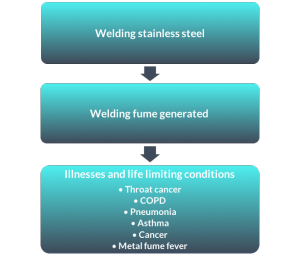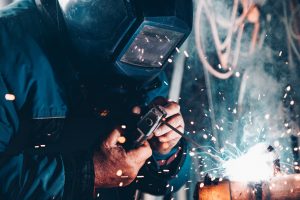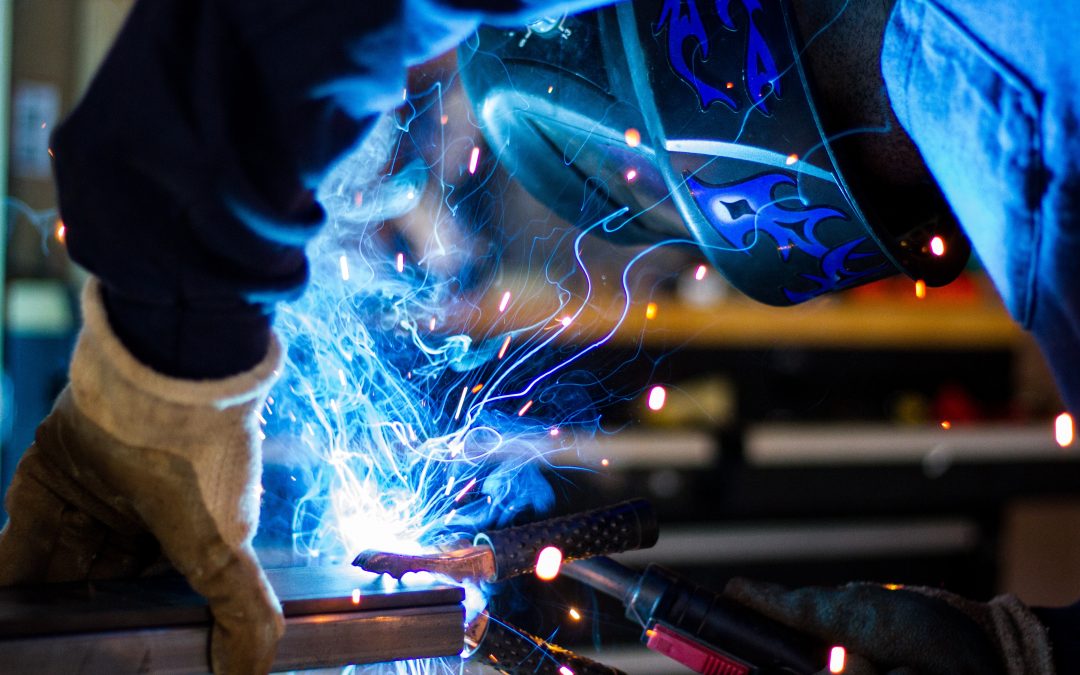The welding of stainless steel generates welding fume, that contains hazardous metal fume and gases, that if not controlled, can lead to the chance of the worker developing a range of illnesses or life limiting conditions, as shown below:

This can however, be controlled using good working practices, with the aim of minimising the risk of employees developing illnesses. The Control of Substances Hazardous to Health (Coshh) Regulations 2002, explain how to control exposure to hazardous substances such as stainless-steel welding fume.
Stainless-steel welding creates chromium oxide and nickel oxide fume that can cause asthma, it’s therefore more hazardous than welding mild steel. In general, a good control solution is one that minimises the health risk, whilst reducing maintenance burdens and being easy to use and maintain.
Adequate Control and Risk Assessment
Consideration needs to be made (as outlined in the Coshh regulations) to determine the best way to ensure adequate control of exposure to hazardous substances. The hierarchy of control outlines this approach as follows:
The risk assessment should firstly be undertaken in order to consider the significant risks, and options for control. Consideration has to be made to eliminate the hazardous substance as the first step.
As welding fume is a by-product of welding, consider whether there is another fabrication method to use instead of welding the item, using a different metal, or whether automated welding is a practical solution. If elimination is not possible, then the next way is to control welding fume at source to minimise the release and spread of the hazardous fume. This may include looking at means of enclosing the process, or segregating the worker from the process, to reduce chance of the fume reaching the welder and other workers. It should not introduce other risks.
Engineering
The use of engineering means can often be an effective way of capturing the welding fume, at the point of creation, by using Local Exhaust Ventilation (LEV). LEV does have to be, first and foremost, designed for the best outcome, if the design is not suitable, then adequate control is at worst unlikely, and thus a health risk, and at best a waste of time and money.
Too many LEV systems spend more time and money on the duct work and fans, yet the design of the capture hood is the most important part. When designed and installed incorrectly, it can sometimes make the whole system completely ineffective, in terms of welding fume exposure control. Good design depends on many factors, including thinking about the type of pollutant, particle size and how it may be captured, and making it easy to use. A specialist needs to design it. It is also essential that it is installed and commissioned properly, thoroughly examined and tested at least every 14 months (or sooner for some situations) and maintained in between.
Once the fumes have been dispersed, if capture at source has not been achieved, trying to minimise worker exposure is more difficult and likely to cost more. Others working nearby, but not doing the actual welding process may also be affected, segregation of the activity is one way of keeping exposure away from those people.

Last resort
The last resort option can be to protect the worker by Personal Protective Equipment (PPE), or design of working methods, organisation or job rotation to restrict the number of people exposed and their extent. Personal Protective Equipment (PPE) can often be an effective, short term measure, and may be needed until a solution that controls fumes more effectively, is developed or used alongside other control measures. The correct PPE should be provided for the situation and the individual. The employees need to be trained on how and when to use it, keep it clean and stored properly, and systems monitored to ensure they are being followed.
Workplace Exposure Limits
Metals found in the welding fume usually have Workplace Exposure Limits (WELs), that relate to health effects to check the extent of personal welding fume exposure. During various stages personal exposure monitoring, through means of an air monitoring survey should be considered to provide evidence of control and information on where to focus the efforts, along with competent occupational hygiene advice. Improvements to the situation need not cost much investment in term of money or time and ideas can often come from the workforce. It is important to note that any control measures need to be easy to use, keep clean, and maintain.
Don’t forget to:
- Maintain and keep in good repair the control measures, including thorough examination and testing of LEV systems as per Coshh regulations (in most cases at least every 14 months)
- Inspect and clean the LEV and enclosure when necessary and at regular intervals.
- Check that suitable PPE is being worn as per the procedure and training.
- Review the situation at regular intervals and review risk assessment when require, or when advised by your safety advisor or occupational hygiene specialist.
- Ensure that a change in the workplace does not lead to new risks.
- Focus on minimising the risk to health and safety as a whole.
- Keep employees informed and use refresher training
Our approach
Get in touch with Workplace Exposure, either give us a call on 0800 689 4386, or fill in our enquiry form to discuss your monitoring or consultancy requirements.
We’ll then provide you with a no obligation proposal, we can often give an initial idea of fees whilst we discuss your needs.
Once you’ve accepted our proposal we can then schedule the work.
Following our site visit we’ll provide you with a comprehensive report giving you advice, recommendations and control measures where appropriate.
Implement the outcomes for compliance and a happier healthier workplace.
Further information
For further reading and information, the British Occupational Hygiene Society (BOHS) are currently running a breathe freely initiative aimed at reducing occupational lung disease in the UK, click here to find out more.
